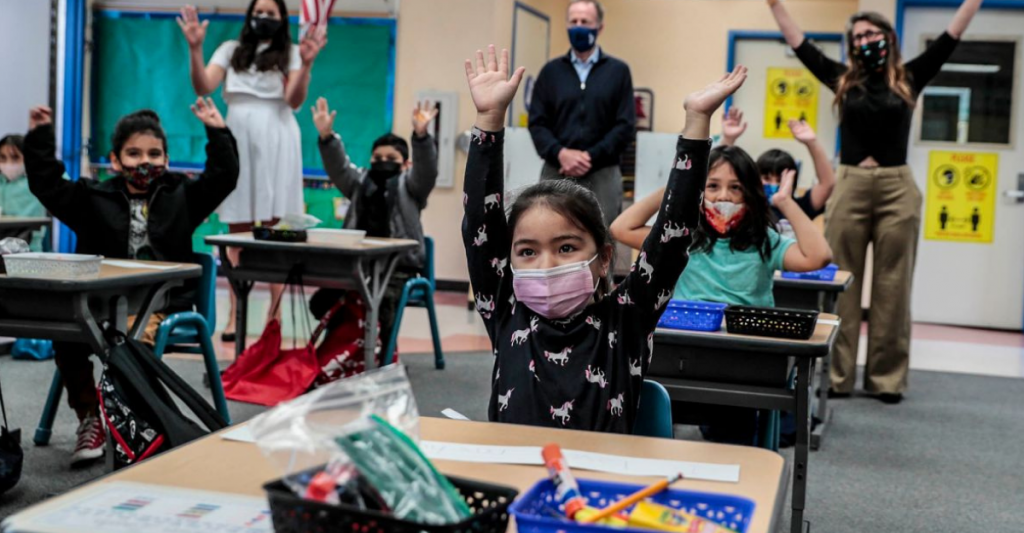In June 2020, the Centers for Disease Control and Prevention (CDC) said in a report that one in four children aged 18 to 24 are suffering from a serious mental health crisis and they are in a dire need of help. The report further highlighted that common symptoms of mental health issues, such as anxiety, depression and suicidal ideation, have increased since the COVID-19 pandemic hit the country.
Depression and suicidal ideation among students have increased over the past year, mainly due to social and economic loss, as well as uncertainty about their future. Many researchers believe that the pandemic could in the long-term adversely affect the future of millions of children.
Schools are ideally placed to tackle students’ behavioral issues. They offer the best resources to reduce stress and anxiety in students and boost their academic performance. Many experts believe that schools must provide a well-organized program to keep students mentally strong and healthy.
Kelly Davis, the associate vice president of peer and youth advocacy at Mental Health America (MHA), says that students who did not seek help from mental health services in the past are now more likely to request mental health support from their colleges. This change has been necessitated by the COVID-19 pandemic, which has altered the rhythm of their lives.
Mental health challenges for students in schools?
Mental health problems among students have always been a great concern and a burden for schools and colleges. It not only hinders their coursework and personal achievement but also decreases the overall performance of the campuses.
In fact, anxiety and depression among students have doubled since the pandemic hit the country last year in early March, revealed a study. According to another study, more than 90 percent of students reported that COVID-19 has severely impacted their lives through stress, anxiety, and loneliness.
Depression:
Regular mood swings, sleep disorders, changes in appetite, loss of interest, hopelessness are common symptoms of depression. Students are not enjoying regular activities, such as sports, reading, meeting with friends, etc are also signs of depression. Apart from them, not attending the classes often, annoying parents and friends, talking about death and suicide are dangerous signs of depression among students.
The 2021 MHA report says that 9.7 percent of American youth have severe depression, compared to 9.2 percent last year.
Anxiety
Feelings of stress and apprehension, trouble concentrating, fearfulness, sweating and dizziness, irritability, irregular heartbeat, and headache are the symptoms of anxiety. For instance, when you face a tragic incident like the loss of someone dear and find it difficult to move on—it can lead to severe anxiety.
A report claimed that seven out of ten teens between the ages of 13 and 17 in the U.S. have anxiety or depression.
Suicide
Health experts believe that extreme levels of depression, anxiety, and loneliness can force youth to have suicidal thoughts. Sometimes a single reason can trigger suicidal tendencies among children. According to CDC, between 2007 and 2018, the national suicide rate among persons aged 10–24 alarmingly increased by 57.4%.
Eating Disorders
Eating disorders are very common among adolescents. Skipping meals or binge eating can be seen in children.
Many health professionals believe that sometimes school children suddenly start skipping meals to lose their weight or to avoid being bullied in class, which leads to eating disorders in teens.
Addiction
College and school students using alcohol and drugs is now a common occurrence and can be a huge cause for concern for both parents and teachers. Addiction can be recognized in children when they exhibit signs of feeling uncomfortable when alcohol and drugs are not available.
Mental Health Programs in schools
Health experts—nurses, psychologists, and counsellors can play a key role in handling students’ mental health problems in schools.
John E. Desrochers, a school psychologist in Westport, Connecticut, says that the “most efficient and effective framework for organizing mental health services in schools is through a multitiered system of support. This framework typically features three tiers of interventions, providing a continuum of care for all students in the school, not simply to those identified as having a disability.” He has divided mental health programs into three tiers.
Tier 1: Universal intervention designed for all students, whether they are experiencing a mental health-related problem or not.
Tier 2: Targeted interventions when schools deploy resources for students at risk of developing emotional or behavioural problems.
Tier 3: Under the intense intervention, the school provides resources for high-risk students who are already suffering from mental health problems.
Mental Health Programs For School Stakeholder, According To Desrochers ADMINISTRATORS • Championing mental health programs as integral to the school curriculum • Planning • Resource allocation • Assessment of program implementation and outcomes TEACHERS • Planning • Implementation SCHOOL MENTAL HEALTH PROFESSIONALS • Research and planning • Staff and parent training • Data analysis: screening and outcomes • Follow-up with individualized assessment and intervention as needed PARENTS • Planning • Reinforce program goals at home • Advocacy for MTSS in the community |
How To Launch Mental Health Program In School
The demand for mental health resources is increasing both in schools and colleges, especially since the COVID-19 hit the planet. Several online and innovative approaches are being deployed by educators to tackle students’ mental health problems.
Health experts believe that mental health programs should become part of the school curriculum to prioritize students’ psychological wellbeing.
Increased Awareness
Mental illness should not be considered taboo at least in school. It should be a part of everyday discourse among students and teachers. To increase awareness about mental health, the school can conduct face to face orientation programs, where they can learn how to fight mental health challenges and how to seek help to deal with it.
Group discussion or open conversation among the students about mental health in the classroom can also play an important role. During the discussion, students can share information or experiences that affected their mental health. This conversation can also help to know where to seek help and how to recognize the symptoms of mental health issues.
Schoolwide Programs
There are several online and offline courses and programs that are being provided by school administrations. In 2018, Florida State University launched an online tool to
respond to students’ mental health needs and improve their psychological wellbeing. The Student Resilience Project offers evidence-informed trauma resilience training tools to all students.
Stanford’s Resilience Project is also one of the preventive approaches to deal with mental health problems in students. The project aims at developing confidence, positivity and
resilience students through videos featuring prominent alumni, faculty and administrators, who talk about their setbacks and how they overcame them.
More than 300 college students are using Kognito—a smart digital solution that caters to the professional development of students, covering mental health, substance use, chronic disease, family relations, medication adherence, and patient-provider communication.
Open Counselling Centers:
Needless to say, the COVID-19 pandemic is putting the spotlight on the need to address the mental health issues in the student community. Many experts say that schools and colleges must come up with a holistic approach to tackle mental health issues.
Alan Leshner, CEO emeritus of the American Association for the Advancement of Science, says that opening counselling centers in school and college campuses could go a long way in counter the stigma of mental illness. The platform can provide free mental health screening to students and give them a space to share their experiences about their depression and anxiety.




